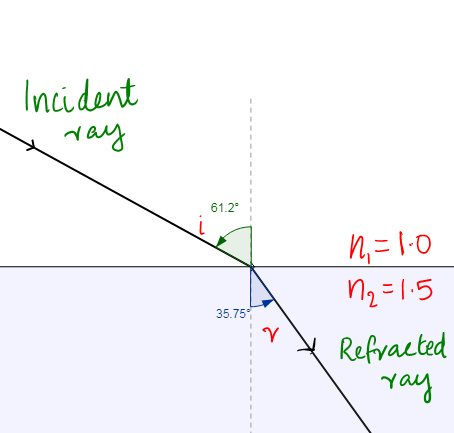
State Snell’s first and second law of refraction.
Answer
592.5k+ views
Hint: Refraction deals with bending of light at the interface of two mediums of different refractive index. So the angle associated with the incidence and refraction can have a relation to the refractive index of the two mediums.
Complete step by step answer:

Snell’s First Law: It states that the incident ray, the refracted ray and the normal lie on the same plane.
Snell’s second law: It states that the ratio of the sines of the angles of incidence and refraction is equivalent to the ratio of phase velocities in the two media, or equivalent to the reciprocal of the ratio of the indices of refraction.
$\dfrac{\sin r}{\sin i}=\dfrac{{{\text{n}}_{\text{1}}}}{{{\text{n}}_{\text{2}}}}=\dfrac{{{\text{v}}_{\text{2}}}}{{{\text{v}}_{\text{1}}}}$
Where,
${{\text{v}}_{2}}$ is the phase velocity of light in medium 2.
${{\text{v}}_{1}}$ is the phase velocity of light in medium 1.
${{\text{n}}_{\text{1}}}$ is the refractive index of medium 1.
${{\text{n}}_{2}}$ is the refractive index of medium 2.
‘r’ is the angle of refraction.
‘i’ is the angle of incidence.
Additional Information:
Snell’s law is responsible for many physical phenomena like mirages, dispersion, apparent depth etc..
In optics, the refractive index of a material is a dimensionless number that describes how fast light travels through the material.
Note: Optical prisms and lenses use refraction to redirect light, as does the human eye. The refractive index of materials varies with the wavelength of light, and thus the angle of the refraction also varies correspondingly. This is called dispersion and causes prisms and rainbows to divide white light into its constituent spectral colors.
Complete step by step answer:

Snell’s First Law: It states that the incident ray, the refracted ray and the normal lie on the same plane.
Snell’s second law: It states that the ratio of the sines of the angles of incidence and refraction is equivalent to the ratio of phase velocities in the two media, or equivalent to the reciprocal of the ratio of the indices of refraction.
$\dfrac{\sin r}{\sin i}=\dfrac{{{\text{n}}_{\text{1}}}}{{{\text{n}}_{\text{2}}}}=\dfrac{{{\text{v}}_{\text{2}}}}{{{\text{v}}_{\text{1}}}}$
Where,
${{\text{v}}_{2}}$ is the phase velocity of light in medium 2.
${{\text{v}}_{1}}$ is the phase velocity of light in medium 1.
${{\text{n}}_{\text{1}}}$ is the refractive index of medium 1.
${{\text{n}}_{2}}$ is the refractive index of medium 2.
‘r’ is the angle of refraction.
‘i’ is the angle of incidence.
Additional Information:
Snell’s law is responsible for many physical phenomena like mirages, dispersion, apparent depth etc..
In optics, the refractive index of a material is a dimensionless number that describes how fast light travels through the material.
Note: Optical prisms and lenses use refraction to redirect light, as does the human eye. The refractive index of materials varies with the wavelength of light, and thus the angle of the refraction also varies correspondingly. This is called dispersion and causes prisms and rainbows to divide white light into its constituent spectral colors.
Recently Updated Pages
A man running at a speed 5 ms is viewed in the side class 12 physics CBSE

State and explain Hardy Weinbergs Principle class 12 biology CBSE

Which of the following statements is wrong a Amnion class 12 biology CBSE

Two Planoconcave lenses 1 and 2 of glass of refractive class 12 physics CBSE

The compound 2 methyl 2 butene on reaction with NaIO4 class 12 chemistry CBSE

Bacterial cell wall is made up of A Cellulose B Hemicellulose class 12 biology CBSE

Trending doubts
What are the major means of transport Explain each class 12 social science CBSE

Which are the Top 10 Largest Countries of the World?

Draw a labelled sketch of the human eye class 12 physics CBSE

Explain sex determination in humans with line diag class 12 biology CBSE

The pH of the pancreatic juice is A 64 B 86 C 120 D class 12 biology CBSE

Give 10 examples of unisexual and bisexual flowers




